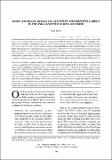| dc.contributor.author | Urton, Gary | |
| dc.date.accessioned | 2017-08-03T17:13:12Z | |
| dc.date.issued | 2005 | |
| dc.identifier | Quick submit: 2014-07-04T09:32:59-04:00 | |
| dc.identifier.citation | Urton, Gary. 2005. “Khipu Archives: Duplicate Accounts and Identity Labels in the Inka Knotted String Records.” Latin American Antiquity 16 (02) (June): 147–167. doi:10.2307/30042809. | en_US |
| dc.identifier.issn | 1045-6635 | en_US |
| dc.identifier.uri | http://nrs.harvard.edu/urn-3:HUL.InstRepos:33702053 | |
| dc.description.abstract | Accounts from the Spanish chronicles regarding Inka record-keeping practices by means of the knotted string devices called khipu ("knot") indicate that these accounts were compiled in a system of "checks and balances." Each community in the empire had a minimum of four khipu accountants, all of whom are said by the chronicler Garcilaso de la Vega to have kept the same records. This study examines several examples of matching khipu accounts identified among sets of two or three khipu. The identification of matching khipu accounts has been facilitated by the recent development of a khipu database at Harvard University. It is argued that certain three-term numerical sequences recorded in one set of three matching khipu from Chachapoyas, northern Peru, represent a type of numerical signifier that may have served as identity labels of the information recorded in this set of khipu. The long-range objective of this research is to investigate the information recorded on khipu from various provenience zones around the former Inka Empire that may represent the remains of khipu archives. /// Relatos en las crónicas españolas relativas a la práctica Inka de mantenimiento de registros por medio de dispositivos de cordeles anudados denominados khipu ("nudo") indican que estos eran recopilados dentro de un sistema de "controles y balances." Cada comunidad en el imperio poseía un mínimo de cuatro "contadores" o registradores de khipu, todos los cuales, según relata cronista Garcilaso de la Vega, llevaban y mantenían los mismos registros. Este estudio examina diversos ejemplos afines y de concordancia compartida, identificados entre conjuntos de dos o tres ejemplares de khipu. La identificación de registros de khipu con afinidad y concordancia ha sido considerablemente facilitada por el reciente desarrollo de una base de datos en la Universidad de Harvard. Se plantea que ciertas secuencias numéricas de tres elementos registradas en un conjunto de tres khipus afines de Chachapoyas en el norte del Perú, representan un tipo de significador numérico que podrían haber fungido o desempeñado como rótulos de identidad de la información registrada en este conjunto de khipus. El objetivo a largo plazo de esta investigación es la de averiguar la información registrada en ejemplares de khipu de diversas zonas del antiguo Imperio Inka, que pudiesen representar los remanentes de archivos de khipu. | en_US |
| dc.description.sponsorship | Anthropology | en_US |
| dc.language.iso | en_US | en_US |
| dc.publisher | Cambridge University Press (CUP) | en_US |
| dc.relation.isversionof | doi:10.2307/30042809 | en_US |
| dash.license | LAA | |
| dc.title | Khipu Archives: Duplicate Accounts and Identity Labels in the Inka Knotted String Records | en_US |
| dc.type | Journal Article | en_US |
| dc.date.updated | 2014-07-04T13:33:00Z | |
| dc.description.version | Version of Record | en_US |
| dc.rights.holder | Gary Urton | |
| dc.relation.journal | Latin American Antiquity | en_US |
| dash.depositing.author | Urton, Gary | |
| dc.date.available | 2017-08-03T17:13:12Z | |
| dc.identifier.doi | 10.2307/30042809 | * |
| workflow.legacycomments | FAR 2014. | en_US |
| dash.contributor.affiliated | Urton, Gary | |


